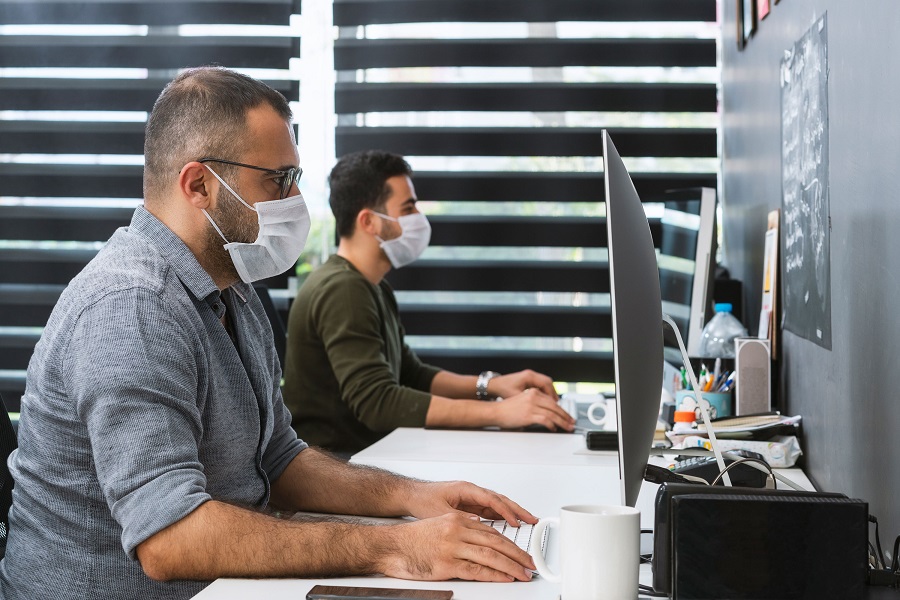If you’re reopening your office, you need a plan to help ensure your employees’ safety.
Employers looking to reopen in states that have lifted stay-at-home mandates should be thoughtful about how to balance safety with productivity and how they can meet the new expectations set by working from home. If you are planning to reopen your office, consider formalizing policies that cover everything from continued remote work to health screenings.
1. Survey employees.
A comprehensive, confidential employee survey is a critical first step, says Emily Goodson, founder and CEO of CultureSmart, a human resources consulting company that works with startups and small businesses.
“The survey need is huge because there’s just so many pieces of information you need to know to make a plan to return to work,” says Goodson.
She recommends creating questions that will answer three high-level questions:
- Are employees ready to come back to the office?
- What do they need to feel safe?
- Who may not be able to return due to limited public transportation or caregiving (for children, elderly parents or ill partners)?
2. Create a phased return.
Employers should approach the office reopening the same way many states are reopening their economies—in phases. Goodson says which teams return first depends on business goals and priorities, but you need succession plans for those teams.
“There’s still a chance someone will bring the virus with them,” Goodson says. “If you bring back an entire team and they all get it at the same time, you need a contingency plan.”Sign up to receive the latest business insightsJoinBy providing your e-mail address, you agree to receive the business insights newsletter from American Express. For more information about how we protect your privacy, please read our Privacy Statement.
Even if employees want to return, Kelly Williams, founding partner and attorney at Slate Law Group, recommends leaving the remote work option open for as long as possible—at least for the next three months or “until the government gives the complete green light.”
“Make it an active choice for employees to come back to work and make sure they understand the risks,” Williams says.
Additionally, she recommends asking employees to sign a written waiver acknowledging they’re actively choosing to return and understand the risks and provide a liability release.
3. Determine the rules for office operations.
Consider social distancing as part of your safety procedures, even if your state doesn’t require it. Besides using remote work, you can limit the number of employees on site by rotating schedules or staggering shifts.
In addition to workspaces, Goodson says you need to think about common areas such as kitchens or breakrooms, conference rooms, elevators and bathrooms. One question to answer is how many people are allowed in each of those areas at one time.
“Kitchens historically have been, at least in the tech industry, a huge gathering and social place, with booths to sit in and snacks for people to share,” she says. “That is not going to happen anymore, and these are the kinds of things teams need to think through.”
4. Adopt safety procedures.
The Occupational Health and Safety Administration (OSHA) requires employers to provide a safe work environment. OSHA has issued various non-regulatory guidance related to the pandemic, including for preparing workplaces for COVID-19.
Scott Warrick, an employment attorney and HR professional, says employers need to understand their obligations under OSHA’s general duty cause. In the past, safety was a common topic in environments such as manufacturing. Professional workplaces, like offices, haven’t had to focus on safety as much—but that’s going to change, Warrick says.
“Every company in the country now needs to get with the safety program—which is health and hygiene,” says Warrick, who’s been providing COVID-19 safety training for employers.ADVERTISEMENTProduct SolutionKeep better tabs on cash flow
We help simplify money management. American Express has the solutions to keep you on top of your spending. Learn More
In addition to providing safety-related equipment and supplies, you need to train employees. Interactive sessions are best for facilitating learning, Warrick says. Ideas include town halls and all-hands virtual meetings.
“People in [professional] fields need to get used to safety meetings, and then each department needs to have regular safety meetings because that is how you will discover what isn’t working,” Warrick says.
Cleaning is another safety component. Require employees to regularly clean their own workspaces and shared surfaces like elevator buttons and breakroom tables, Warrick advises.
Additionally, Williams recommends considering nightly disinfection by a commercial service.
“It’s an added expense but it’s better to be safe than sorry,” she says. “Make sure you check your state guidelines on the exact requirements.”
5. Implement health screenings.
Thomas Ahrens, founder of Viven Health, which developed a science-based protocol for safe reopening after COVID-19, believes that daily screening for COVID-19 symptoms is a preventative measure that greatly reduces the risk of employee exposure.
He recommends, as a basic minimum, taking temperatures and pulse oximeter readings, as well as asking questions such as whether the person has a new cough or shortness of breath, has lost sense of taste or smell or is feeling sick (which could include sore throat, muscle aches, chills and fatigue).
“If the person says no to all the questions, doesn’t have a fever or a low pulse on the oximeter reading, you probably have an 80-90% chance they’re safe and can come to work,” Ahrens says.
Screening can take five minutes or less per employee, and Ahrens recommends using several devices.
“With multiple devices, you could screen a hundred people in about 15 minutes,” he says.
Self-screening and self-reporting is one option. If you plan to have someone administer the screening, however, make sure you follow all the applicable laws, Williams advises.
“HIPAA and privacy can also create potential issues so make sure you explain the policy and the reason behind it, and get the appropriate waiver,” she says.
6. Understand privacy requirements.
Privacy and confidentiality also apply to reporting symptoms and illness, notes Goodson. Train supervisors on disclosure procedures. Additionally, have a policy on how to inform individuals who have been exposed to an infected co-worker in the office while respecting confidentiality.
“Thinking through all that before you let people back to the office is paramount,” she says.
7. Update your handbook.
Once you’ve created the policies, update the employee handbook. Williams says the handbook should include components like safety, return-to-work and screening policies and protocols, as well as information about the new federal guidelines on sick leave and paid time off included in the Families First Coronavirus Response Act (and amended in the CARES Act).
People in [professional] fields need to get used to safety meetings, and then each department needs to have regular safety meetings because that is how you will discover what isn’t working.
—Scott Warrick, employment attorney
“I would create a COVID-19 appendix to the handbook and make sure it reflects your updated policies,” Williams says. “When employees get back to work, make sure they read the appendix and sign that they agree to abide by those policies.”
8. Communicate the policies.
Don’t stop at handbook distribution when it comes to communicating the new policies. And don’t rely on email, Goodson says, because everyone is overwhelmed by email right now and “feeling whiplash from all the information coming at them.”
“You can’t expect employees to absorb all that information, so you need to be really intentional about having people come to a virtual training session or maybe do an onboarding session at the office,” she says. “Be thoughtful about how you’re communicating this—you want to make sure employees feel safe and supported.”
americanexpress

